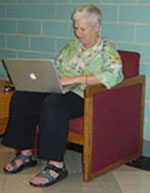
 |
To say that the possibilities for composing through multimodal means are endless seems at once cliché and truth, for a multimodal approach to composition requires an opening of doors and attitudes that may lead to heretofore unexplored and as-yet-to-be experienced places. By definition, multimodal "texts resemble--in many ways--other texts that students have been producing elsewhere in the academy (or in formal educational settings) in response to more conventional assignments like essay tests, lab reports, and research papers" (Takayoshi, Hawisher, & Selfe, 2007, p.1). What differentiates multimodal texts, though from their more traditional counterparts, is that multimodal composing goes beyond the alphabetic to include any combination of images, sound, color, animation and text (Takayoshi, Hawisher, & Selfe, 2007, p.1). Moreover, these texts, which most often occupy a predominately digital space, may also be created in trailing-edge environments via the utilization of tape recordings, poster-board, markers, and notebook paper if computer access is limited or unavailable. Whatever the tools, the rationale behind multimodal instructional strategies remains the same: it forces "teachers of composition . . . to pay attention to, and come to value, the multiple ways in which students compose and communicate meaning . . .in both non-digital and digital environments--to meet their own needs in a changing world" (Selfe, forthcoming, p. 28).
In her book, Talking, Sketching, Moving: Multiple Literacies in the Teaching of Writing , Patricia Dunn (2001, p. 8) urges writing teachers "to use multiple, alternate strategies to teach writing." In her view, since "words are so powerful", composition instructors "must use all available means to help students discover the power of words and their own power to use them" (Dunn, 2001, p. 8). Furthermore, Dunn (2001, p. 29) argues that "[w]riting and its role in thinking does not have to be conceived of as a binary. We can still believe in the primacy of language even as we hold it suspect." In other words, questioning the role of print texts in the 21st Century does not necessarily mean the discarding of such texts; instead, it is possible to meld traditional elements of writing with non-traditional, multimodal elements in order to create new texts and new meanings from new thoughts. As Pamela Takayoshi, Gail Hawisher, and Cindy Selfe (2007, p. 8) suggest, "basic composing strategies have changed," and as a result, "basic composition instruction, too, must change in order to provide students an introductory, rhetorically focused introduction to a wider range of semiotic resources." Simply put, multimodal composing strategies have the possibility of empowering students who may have previously felt limited by written communication that consisted solely of alphabetic text. To engage in rhetorical acts via multimodal means, then, is to provide options and to expand as well as layer literacies: alphabetic amongst visual amongst aural and beyond.
To listen to Dr. Cindy Selfe's and pre-service teacher Jeremy Brown's views on possibilities for multimodal composing, play the videos to the right of the screen.